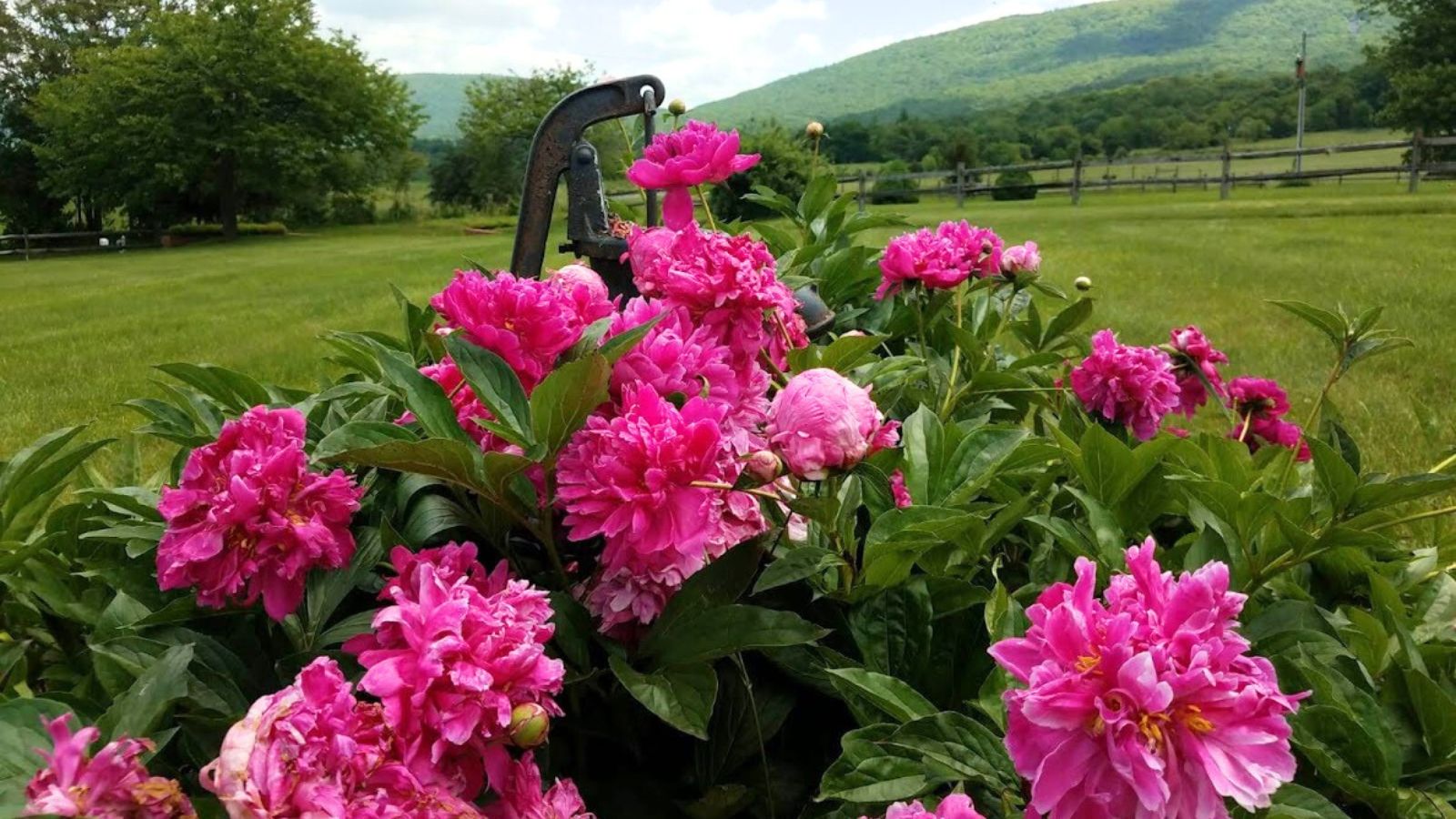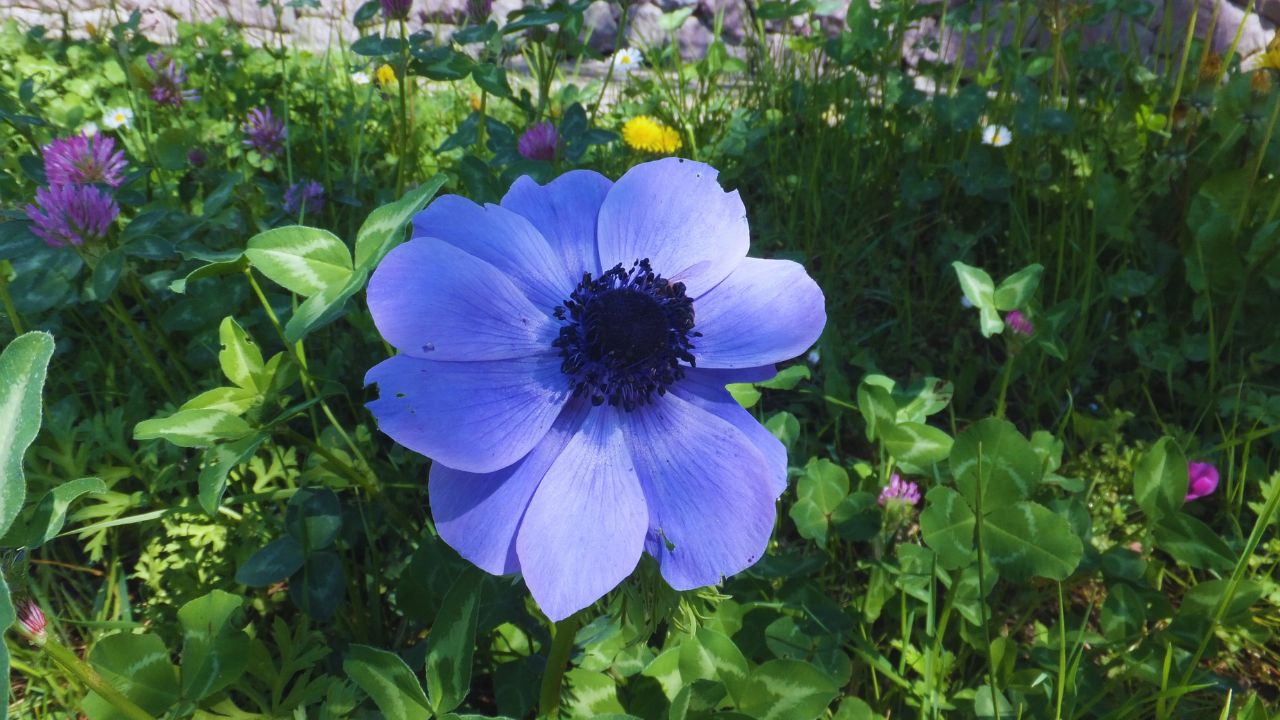Landscaping under any tree can be challenging, thanks to the dense shade cast by the branches and the abundance of thick roots in the soil. But black walnut trees (Juglans nigra) seem to be in a category all their own; nothing will grow anywhere near them!
Although landscaping under black walnut trees may feel like an impossible task, with a few creative ideas and tips, and a list of plants that will survive near black walnuts, you can transform that lifeless space into a beautiful garden extension.
Landscaping Under Black Walnut Trees
Why won’t anything grow under these trees?
Black walnut trees produce a chemical called juglone as a protective response to ensure the tree’s survival. This chemical is released from the roots and is also found in smaller concentrations in the leaves, bark, wood, and nut hulls. While other types of trees also produce juglone, black walnuts and butternuts tend to cause the most problems.
Plants sensitive to juglone exhibit yellowed and wilting leaves, often followed by death. This happens because juglone inhibits respiration, depriving plants of nutrient and water uptake, energy, and cell division.
Because juglone is not very water-soluble, it does not travel far into the soil. Plants within the dripline or the edge of the canopy will be most susceptible to juglone. However, the toxic zone around a mature black walnut can extend 50 to 60 feet from the trunk, given that tree roots often grow farther than the branches. Even after removing a black walnut tree, its decaying roots may continue releasing juglone for several years afterward, so juglone-sensitive plants should still be avoided at first.
The Top Landscaping Tip for Black Walnut Trees
Plant Farther Away
Perhaps the most obvious solution is to locate plants at least 50 feet away from the trunk of a black walnut tree. This is particularly important for juglone-sensitive plants, whereas those with a higher tolerance for the chemical will be able to survive closer to the tree, especially when provided with healthy soil.
Install Raised Beds
Try installing raised beds to sneak plants in closer to a black walnut tree. This will limit root contact, thus reducing juglone exposure. For best results, line the bottom of each raised bed with landscape fabric before filling it with new topsoil.
Raised bed gardens can be built in almost any shape and with a wide range of materials, so you don’t need to feel boxed in by this idea. They also offer myriad benefits, including improved drainage, warmer soil for earlier planting, fewer weeds, and easier access.
Only build raised beds outside the tree’s dripline, as piling too much soil too close to the trunk can suffocate the surface roots (located within the top foot or so of soil) and damage or even kill the tree. However, you can arrange a few lightweight flowerpots under the canopy for a wider variety of plants and a fuller appearance.
Improve the Soil
Although juglone from leaves and nut hulls typically breaks down in the soil, poor drainage and wet conditions can cause it to accumulate, further reducing the likelihood that any other plants will survive. On the other hand, well-drained, properly aerated soil with a healthy microbe population can accelerate juglone decomposition.
To ensure the best possible planting conditions around a black walnut tree, incorporate organic matter, such as compost, into the soil before planting. Take care not to damage any tree roots while digging, and add only about two inches of organic matter to avoid suffocating the roots.
With most trees, it’s best to let fallen leaves remain where they lie, but you can further reduce the concentration of juglone in the soil around a black walnut tree by keeping the area clean. Remove fallen leaves, hulls, and twigs from your growing spaces and dispose of them in a brush or weed pile.
Have a Seat
Take advantage of the cool shade your black walnut tree casts and place a bench or a pair of garden chairs under its branches. Imagine reading a book or enjoying a refreshing glass of iced tea there on a hot summer day! You can throw a bamboo mat under it to minimize any mud if needed. It could even be a great place for a child’s swing.
A figurine or two might also find itself at home under a black walnut tree, along with other nonliving items. Perhaps a garden gnome could stand guard next to a toad house, with a tiny door against the tree trunk suggesting the entrance to his own home. Decorative stones or shells also help fill space where plants cannot.
Choose Juglone-tolerant Plants (and Keep Sensitive Ones Away)
Some plants have shown tolerance to juglone under various settings. As hinted above, multiple factors affect plants’ sensitivity or tolerance to juglone, including soil conditions, juglone concentration, and plant health. While plants with a greater juglone tolerance might grow under the canopy, they will have a greater likelihood of survival the farther away from the trunk they are planted.
Juglone tolerance exists in various plants, from vegetables to trees, so regardless of what type of garden you have in mind for the space, you should be able to find some plants that will fit your vision and survive the black walnut tree. Larger and taller plants should be located farther away from the tree to reduce competition with the tree and avoid damaging the roots when planting.
Keep Jualone-Sensitive Plants Away

Image credit: Backyard Garden Lover.
Some of the most juglone-sensitive plants include the following:
Sensitive Flowers
- Blue false indigo
- Columbine
- Forget-me-not
- Lily
- Peony
- Petunia
Sensitive Vegetables
- Asparagus
- Eggplant
- Pepper
- Potato
- Rhubarb
- Tomato
Sensitive Fruits
- Apple
- Blackberry
- Blueberry
- Grape
- Pear
- Strawberry
Sensitive Trees and Shrubs
- Azalea
- Lilac
- Potentilla
- Rhododendron
- Viburnum
- Basswood
- Birch
- Hackberry
- Pine
- Silver maple
- Saucer magnolia
Plants That Grow Well Under Black Walnut Trees

Image Credit: Syrio – Own work, CC BY-SA 4.0/Wiki Commons.
According to PennState Extension, the following plants have exhibited juglone tolerance and thus are most likely to thrive near a black walnut tree. Try a variety of plants from this list and see what works best in your setting – there are quite a few to choose from!
Less Sensitive Flowers
- Anemone (Anemone spp.)
- Aster (Aster spp.)
- Astilbe (Astilbe spp.)
- Bee balm (Monarda spp.)
- Bellflower (Campanula latifolia)
- Bleeding heart (Dicentra spp.)
- Bloodroot (Sanguinaria canadensis)
- Bugleweed (Ajuga reptans)
- Christmas fern (Polystichum acrostichoides)
- Christmas rose (Helleborus spp.)
- Chrysanthemum (Chrysanthemum spp.)
- Cinnamon fern (Osmunda cinnamomea)
- Common daylily (Hemerocallis spp.)
- Coral bells (Heuchera spp.)
- Cranesbill geranium (Geranium sanguineum)
- Crested wood fern (Dryopteris cristata)
- Crocus (Crocus spp.)
- Daffodil (Narcissus spp.)
- Dog’s tooth violet (Erythronium spp.)
- Dutchman’s breeches (Dicentra cucullaria)
- Epimedium (Epimedium spp.)
- European wild ginger (Asarum europaeum)
- Fibrous and tuberous begonia (Begonia spp.)
- Gentian (Gentian spp.)
- Globeflower (Trollius spp.)
- Glory of the snow (Chionodoxa lucilae)
- Grape hyacinth (Muscari botryoides)
- Hollyhock (Alcea rosea)
- Hosta (Hosta spp.)
- Iris (Iris spp.)
- Jack-in-the-pulpit (Arisaema triphyllum)
- Jacob’s ladder (Polemonium reptans)
- Lamb’s ear (Stachys byzantia)
- Leopard’s bane (Doronicum spp.)
- Lilyturf (Lirope spp.)
- Lobelia (Lobelia spp.)
- Lungwort (Pulmonaria spp.)
- Mayapple (Podophyllum peltatum)
- Meadowrue (Thalictrum spp.)
- Morning glory (Ipomoea spp.)
- Orange hawkweed (Hieracium auranticum)
- Pansy and violet (Viola spp.)
- Phlox (Phlox paniculata)
- Pot marigold (Calendula officinalis)
- Primrose (Primula spp.)
- Primrose and sundrops (Oenothera spp.)
- Purple coneflower (Echinacea purpurea)
- Shasta daisy (Leucanthemum x superbum)
- Siberian or blue squill (Scilla siberica)
- Snowdrop (Galanthus nivalis)
- Solomon’s seal (Polygonatum commutatum)
- Spanish bluebell (Hyacinthoides hispanicus)
- Spiderwort (Tradescantia virginiana)
- Spring beauty (Claytonia virginica)
- St. John’s wort (Hypericum spp.)
- Stonecrop (Sedum acre or Sedum spectabile)
- Sunflower (Helianthus spp.)
- Sweet woodruff (Galium odoratum)
- Trillium (Trillium spp.)
- Tulips (Tulipa spp.)
- Virginia bluebell (Mertensia pulmonariodes)
- Winter aconite (Eranthis hyemalis)
- Yarrow (Achillea spp.)
- Zinnia (Zinnia spp.)
Less SensitiveVines
- Clematis (Clematis spp.)
- Virginia creeper (Parthenocissus quinquefolia)
- Wild grape (Vitis spp.)
- Wisteria (Wisteria spp.)
Less Sensitive Shrubs
- American holly (Ilex opaca)
- Barberry (Berberis spp.)
- Black raspberry (Rubus occidentalis)
- Current (Ribes spp.)
- Daphne (Daphne spp.)
- Elderberry (Sambucus Canadensis)
- Exbury hybrid azalea (Rhododendron ‘Balzac’ or ‘Gibraltar’)
- Forsythia (Forsythia spp.)
- Juniper (Juniperus spp.)
- Koreanspice viburnum (Viburnum carlesii)
- Maple-leaved viburnum (Viburnum acerifolia)
- Mock orange (Philadelphus spp.)
- Pinxterbloom azalea (Rhododendron periclymenoides)
- Rose of Sharon (Hibiscus syriacus)
- Smooth sumac (Rhus glabra)
- Snowball hydrangea (Hydrangea arborescens)
- Spicebush (Lindera benzoin)
- St. Johns wort (Hypericum prolificum)
- Sumac (Rhus copallina)
- Witch hazel (Hamamellis spp.)
Less Sensitive Trees
- American beech (Fagus grandifolia)
- American elm (Ulmus americana)
- Arborvitae (Thuja occidentalis)
- Black cherry (Prunus serotina)
- Black gum (Nyssa sylvatica)
- Black locust (Robinia pseudoacacia)
- Blackhaw viburnum (Viburnum prunifolium)
- Canada hemlock (Tsuga canadensis)
- Carolina silverbell (Halesia caroliniana)
- Catalpa (Catalpa bignoniodes)
- Dogwood (Cornus alternifolia)
- Eastern red cedar (Juniperus virginiana)
- Eastern redbud (Cercis canadensis)
- Flowering dogwood (Cornus florida)
- Fringe tree (Chionanthus spp.)
- Golden rain tree (Koelreuteria paniculata)
- Hawthorne (Crataegus spp.)
- Hazelnut (Corylus americana)
- Hickory (Carya spp.)
- Honey locust (Gleditsia triacanthos)
- Maple (Acer spp.) — except silver
- Oak (Quercus spp.)
- Ohio buckeye (Aesculus glabra)
- Pawpaw (Asimina triloba)
- Persimmon (Diosypros virginiana)
- River birch (Betula nigra)
- Sassafras (Sassafras albidum)
- Serviceberry or shadblow (Amelanchier spp.)
- Staghorn sumac (Rhus typhina)
- Sweetgum (Liquidambar styraciflua)
- Sycamore (Platanus occidentalis)
- Virginia pine (Pinus virginiana)
- White ash (Fraxinus americana)
- Yellow poplar (Liriodendron tulipifera)
Fruit Trees and Vines
- Black raspberry (Rubus occidentalis)
- Cherry (Prunus spp.)
- Nectarine (Prunus spp.)
- Peach (Prunus spp.)
- Plum (Prunus spp.)
- Quince (Cydonia oblongata)
- Wild grape (Vitis spp.)
Less Sensitive Vegetables
- Bean
- Beet
- Carrot
- Corn
- Jerusalem artichoke
- Melon
- Onion
- Parsnip
- Squash
While the black walnut tree in your yard may seem to pose an impossible landscaping challenge, you can see from the remarkably long list above that many plants can survive the toxic chemical it releases.



Karen
Thursday 1st of June 2023
What is the name of the specific clematis pictured in the article "Landscaping Under Black Walnut Trees. It looks like a white or pink flower with a deeper pink stripe the length of each petal. Thanks!
Adriana
Thursday 1st of June 2023
I thin it's called Cherokee clematis.
De'Borah
Tuesday 19th of July 2022
Thank you for the list of so many plants that I now know will thrive under my Black Walnut tree. I love all types of Sedum and I'm wondering if you could tell me if they too will survive under the Black Walnut tree?
Adriana
Tuesday 19th of July 2022
Give it a try. Stonecrop sedum might work there.